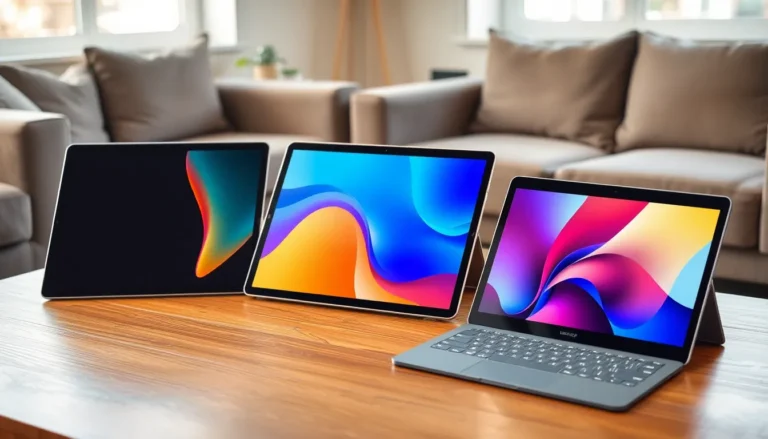In a world overflowing with notebooks, finding the perfect one can feel like searching for a needle in a haystack—or worse, like trying to find a Wi-Fi signal in the middle of nowhere. With so many options out there, it’s easy to get overwhelmed by the endless features and specs. That’s where notebook comparison charts come to the rescue, swooping in like a superhero in a cape (or maybe just a really organized friend).
Table of Contents
ToggleOverview of Notebook Comparison Charts
Notebook comparison charts serve as essential tools when selecting the right device for personal or professional use. These charts simplify the evaluation process by consolidating various features into an easily digestible format. Key specifications often included are screen size, battery life, and processing power.
Users can quickly focus on relevant attributes that matter most to them by reviewing side-by-side comparisons. Performance metrics displayed in these charts allow for immediate visual insights, helping individuals identify their preferred options. Examples of additional features covered in charts might include weight, price, and connectivity options.
Many notebooks offer different customizations and configurations, making direct comparisons invaluable. With a variety of brands and models available, comparison charts ensure the selection process remains streamlined. Integrating updates on new releases or discontinued models keeps users informed about current trends.
Charts not only provide valuable data but also highlight customer reviews and ratings. By considering user feedback alongside technical specifications, potential buyers can make more informed decisions. Overall, notebook comparison charts act as a practical guide, transforming an overwhelming selection process into a structured and user-friendly experience.
Importance of Notebook Comparison Charts

Notebook comparison charts play a crucial role in guiding consumers through the vast landscape of notebook options. These tools streamline the decision-making process, enabling users to focus on key features that matter most.
Helping Consumers Make Informed Choices
Comparison charts help consumers make informed choices by presenting essential data in one place. Details like screen size, battery life, and processing power stand out clearly in these charts. Immediate visual insights assist users in evaluating their preferences. Users can directly contrast specifications, allowing for precise comparisons. The inclusion of customer reviews adds another layer of confidence, guiding potential buyers in their selections.
Simplifying Complex Information
Complex information becomes manageable through the use of comparison charts. They distill intricate specifications into an easily digestible format. Each chart showcases attributes such as weight, price, and connectivity options effectively. Users find clarity in navigating through numerous brands and models. By consolidating data, these charts alleviate confusion and present straightforward choices. Regular updates on new releases ensure users remain informed about the latest trends in the market.
Key Features to Look for in Comparison Charts
When evaluating notebook comparison charts, specific features enhance the selection process. These features provide clarity and support informed decisions.
Specifications and Performance
Specifications provide invaluable insights into notebook performance. Important metrics include processing power, memory capacity, and graphics capabilities. For example, a laptop with an Intel Core i7 processor typically delivers faster performance than a device with an i5. Battery life also plays a crucial role, as longer-lasting batteries maximize portability. Screen resolution impacts user experience, especially for graphic design or video editing tasks. Ultimately, understanding these specifications empowers users to choose a notebook that fits their requirements.
Price and Value Analysis
Price serves as a significant factor in the decision-making process. Comparison charts typically display prices alongside key features, enabling side-by-side evaluations. Users should consider not just the cost but also the overall value each notebook provides. For instance, a lower-priced model may lack essential features, affecting long-term usability. Conversely, premium models often justify higher prices with enhanced capabilities and durability. By analyzing price in the context of features, users can identify notebooks that deliver the best value for their investments.
Popular Notebook Comparison Charts
Notebook comparison charts simplify the selection process by consolidating essential specifications. Users often seek out charts that include attributes like screen size and battery life. Reliable sources such as TechRadar and CNET regularly provide updated charts, which make comparisons straightforward.
Several renowned models appear frequently in these charts. Apple’s MacBook Air is popular due to its sleek design and impressive battery life. Dell’s XPS series often ranks high for performance and build quality, appealing to professionals and students alike. HP’s Spectre lineup combines aesthetics with powerful features, earning a dedicated following.
Metrics presented in these charts vary, but performance evaluation remains a priority. Users can compare processing power measured in GHz, RAM in GB, and storage options listed in TB. These factors significantly influence user experience across different tasks, like gaming or video editing.
Features like weight and connectivity options receive equal attention in reliable charts. Lightweight models facilitate portability for users on the go, while varied ports enhance connectivity based on user preferences. Price remains a crucial component as well, enabling users to assess value in relation to features.
Consumer insights also play a vital role in decision-making. Some comparison charts integrate user reviews and ratings, guiding potential buyers with real-world feedback. By showcasing customer experiences, they further enhance the ability to make informed choices.
Regular updates ensure these charts reflect the latest releases or discontinued models. Staying informed about current trends allows users to choose between the best available options. Overall, these comparison charts serve as invaluable resources for anyone navigating the complex notebook landscape.
Tips for Creating Effective Comparison Charts
Creating effective comparison charts requires a clear understanding of the key features users prioritize. Start by defining the essential specifications that matter most, such as screen size, battery life, processing power, and weight. It’s crucial to ensure these features are presented in an easily digestible format, enabling users to make quick evaluations.
Include visual elements like bar graphs or icons to enhance the chart’s clarity. This approach allows for immediate recognition of differences between models, improving user engagement. Maintain consistency in layout so users can compare similar attributes across various notebooks seamlessly.
Incorporate price alongside specifications to give consumers an optimal understanding of value. This method supports informed decision-making, as users can weigh features against costs more effectively. Highlight customer reviews and ratings, as they offer valuable insights and build trust in the selection process.
Regularly update the charts to reflect the latest releases and discontinued models. Current information keeps users informed about market trends and ensures they have access to the best options available. Focus on high-quality sources, such as TechRadar and CNET, to gather accurate data that reinforces the chart’s reliability.
Lastly, ensure the comparison charts are mobile-friendly. A significant number of users access information on mobile devices, and a responsive design enhances accessibility. Well-structured comparison charts transform an overwhelming selection process into a straightforward experience, guiding users toward the ideal notebook confidently.
Navigating the world of notebooks can be daunting but utilizing comparison charts transforms this challenge into a manageable task. These charts not only consolidate essential specifications but also present them in a clear and concise format. By focusing on critical features and incorporating user reviews, they empower consumers to make informed decisions.
Staying updated with the latest models and trends enhances their effectiveness, ensuring users have access to the most relevant information. With the right comparison chart, individuals can confidently identify the notebook that best suits their needs, saving time and effort in the selection process. Embracing these tools is a smart strategy for anyone looking to invest in a notebook that meets their unique requirements.









